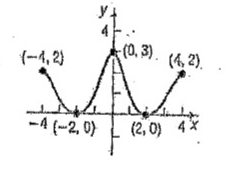Use the graph of the function f to answer 6-9. Find the x- and y-intercepts, if any. State the intervals on which it is increasing, decreasing, or constant. State the domain and range. Is the function even, odd, or neither? (-4,2) -4 (-2,0) (0.3). (4,2). (2,0) 4X
Use the graph of the function f to answer 6-9. Find the x- and y-intercepts, if any. State the intervals on which it is increasing, decreasing, or constant. State the domain and range. Is the function even, odd, or neither? (-4,2) -4 (-2,0) (0.3). (4,2). (2,0) 4X
Advanced Engineering Mathematics
10th Edition
ISBN:9780470458365
Author:Erwin Kreyszig
Publisher:Erwin Kreyszig
Chapter2: Second-order Linear Odes
Section: Chapter Questions
Problem 1RQ
Related questions
Question
![### Graph Analysis of Function \( f \)
#### 6. Find the \( x \)- and \( y \)-intercepts, if any.
- **\( x \)-intercepts:** \((-2, 0), (2, 0)\)
- **\( y \)-intercept:** \((0, 3)\)
#### 7. State the domain and range.
- **Domain:** \([-4, 4]\)
- **Range:** \([0, 4]\)
#### 8. State the intervals on which it is increasing, decreasing, or constant.
- **Increasing:** \((-4, -2)\) and \((0, 2)\)
- **Decreasing:** \((-2, 0)\) and \((2, 4)\)
- **Constant:** None
#### 9. Is the function even, odd, or neither?
- **Neither**
### Graph Description
The graph is a piecewise curve plotted on a coordinate plane. It includes:
- Peaks at \((-4, 2)\) and \((4, 2)\).
- A maximum point at \( (0, 3) \).
- \( x \)-intercepts where the curve crosses the x-axis at \((-2, 0)\) and \((2, 0)\).
- The curve increases from \(-4\) to \(-2\) then decreases to \(0\), increases from \(0\) to \(2\), and decreases again to \(4\).](/v2/_next/image?url=https%3A%2F%2Fcontent.bartleby.com%2Fqna-images%2Fquestion%2F1bafa714-33cc-47c4-a9a5-96cfac78ec18%2F64bd131a-43eb-4490-8492-30e0ea451468%2Ffg4wh6_processed.jpeg&w=3840&q=75)
Transcribed Image Text:### Graph Analysis of Function \( f \)
#### 6. Find the \( x \)- and \( y \)-intercepts, if any.
- **\( x \)-intercepts:** \((-2, 0), (2, 0)\)
- **\( y \)-intercept:** \((0, 3)\)
#### 7. State the domain and range.
- **Domain:** \([-4, 4]\)
- **Range:** \([0, 4]\)
#### 8. State the intervals on which it is increasing, decreasing, or constant.
- **Increasing:** \((-4, -2)\) and \((0, 2)\)
- **Decreasing:** \((-2, 0)\) and \((2, 4)\)
- **Constant:** None
#### 9. Is the function even, odd, or neither?
- **Neither**
### Graph Description
The graph is a piecewise curve plotted on a coordinate plane. It includes:
- Peaks at \((-4, 2)\) and \((4, 2)\).
- A maximum point at \( (0, 3) \).
- \( x \)-intercepts where the curve crosses the x-axis at \((-2, 0)\) and \((2, 0)\).
- The curve increases from \(-4\) to \(-2\) then decreases to \(0\), increases from \(0\) to \(2\), and decreases again to \(4\).
Expert Solution
Step 1: Introduction of the given problem

Step by step
Solved in 6 steps with 18 images

Recommended textbooks for you

Advanced Engineering Mathematics
Advanced Math
ISBN:
9780470458365
Author:
Erwin Kreyszig
Publisher:
Wiley, John & Sons, Incorporated

Numerical Methods for Engineers
Advanced Math
ISBN:
9780073397924
Author:
Steven C. Chapra Dr., Raymond P. Canale
Publisher:
McGraw-Hill Education

Introductory Mathematics for Engineering Applicat…
Advanced Math
ISBN:
9781118141809
Author:
Nathan Klingbeil
Publisher:
WILEY

Advanced Engineering Mathematics
Advanced Math
ISBN:
9780470458365
Author:
Erwin Kreyszig
Publisher:
Wiley, John & Sons, Incorporated

Numerical Methods for Engineers
Advanced Math
ISBN:
9780073397924
Author:
Steven C. Chapra Dr., Raymond P. Canale
Publisher:
McGraw-Hill Education

Introductory Mathematics for Engineering Applicat…
Advanced Math
ISBN:
9781118141809
Author:
Nathan Klingbeil
Publisher:
WILEY

Mathematics For Machine Technology
Advanced Math
ISBN:
9781337798310
Author:
Peterson, John.
Publisher:
Cengage Learning,

